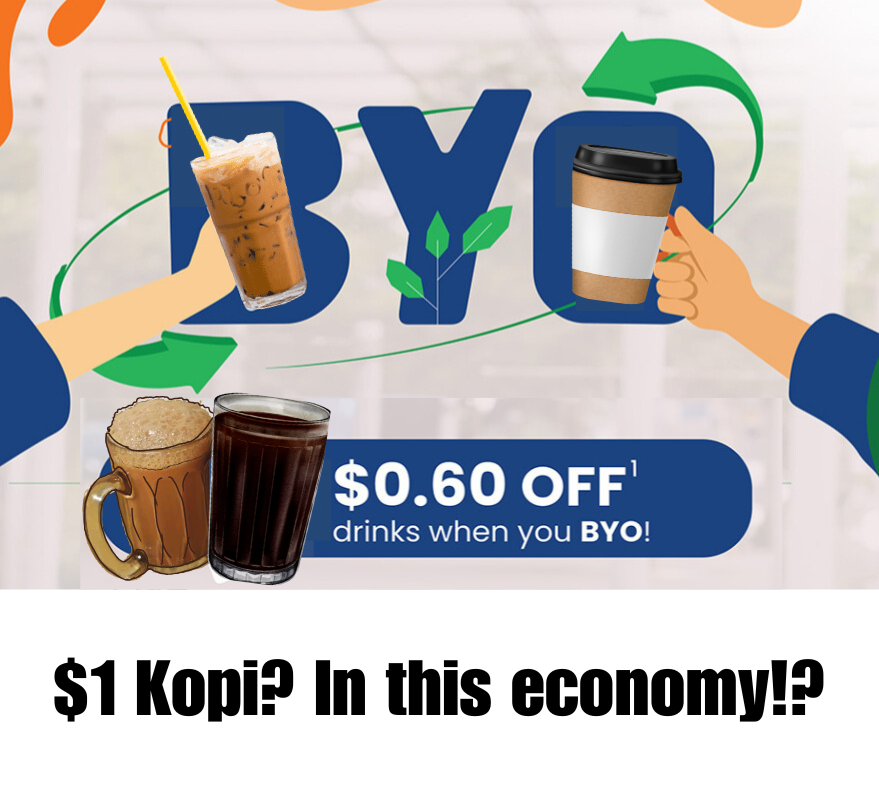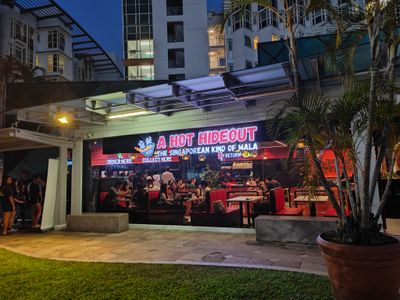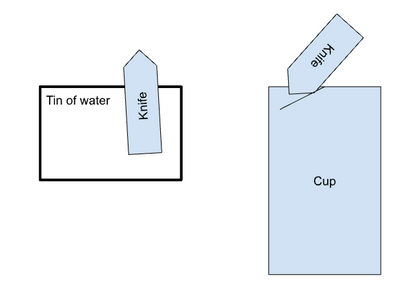To Coffee or Not to Coffee? That is the Question.
As I walk towards the drinks stall, I open the PayLah app on my phone, scan the payment QR code, and input “$1.60”. In the time it takes for me to transfer the money and show the drinks stall auntie that I’ve paid, the magical, black elixir of life appears on the counter. It seems to have materialised out of thin air. Not a word exchanged, just a couple of smiles and knowing nods. A daily exchange, sometimes even twice a day. Her knowing my order is but a question of eventuality.
The elixir in question? Kopi O Kosong Peng, affectionately known as “KOK”.
Despite the large cup being affordably priced at $1.60, when one buys one to two (and occasionally, three) cups of KOK a day, it adds up. So, on days when I have afternoon classes, the protracted inner debate on whether I should have my second KOK of the day plagues me. The scant brain space I have left for crim/contracts/LARC is now ruthlessly stolen by the Caffeine Consumption Conundrum (CCC).
Then, having heard the horror stories of the rigours of Year Two, I spent the better half of summer worrying for my wallet. The CCC was about to get a whole lot worse.
But that was when The Announcement came.
A friend of mine (another chronic KOK consumer and CCC victim) from another faculty sent me a file one fine day, with the caption “YAYYYYY”. Seeing the number of “y”s in his yay, my curiosity was naturally piqued.
When I clicked on the file, a beam of radiant sun shone down on me. A choir of angels appeared, singing a melodious “BYO!”. Okay, that didn’t happen. But I immediately replied to my friend: YAYYYYY.
The BYO Campaign: $0.60 off drinks when you bring your own bottle, and an additional $0.20 when you opt for non-reusables.
$1 KOK? In this economy? This must be a dream! For the next semester, I would be free from the shackles of the CCC. I could buy two, three, maybe even four KOKs, guilt-free!
Feeling like a soldier equipped with the best weapons for war, I trudged into the new academic year. Very quickly, the truths of seniors’ lamentations over Year Two materialised. Many times, I found my legs carrying me to the drinks stall during lesson breaks, the din of the CCC drowned out by “BYO! BYO! $1 KOK!”.

The BYO Campaign: Environmentalism Meets Caffeine Enablement?
After three weeks of steady KOK consumption, it got me thinking. It’s no secret that us law students, on average, are more caffeinated than our peers from other faculties. So, does the BYO campaign, while aiming to reduce single-use plastic waste, unintentionally encourage caffeine consumption?
Employing the extremely scientific method of “agar-ation” (approximation), I roughly gauged the queuing times for drinks during the BYO campaign, and compared them against the queueing times for drinks before the BYO campaign. Apart from one particularly bad day when I ended up being late for my property lecture due to the length of the queue, there actually wasn’t a perceptible increase in the queuing times I experienced, which suggests to me that people weren’t buying many more drinks than before the campaign.
The conclusion? I am the anomaly, and I just exposed my unhealthy relationship with coffee through this article. But caffeine addiction aside, my next curiosity was, how many disposable cups are being saved through this campaign?
I pictured my Geographical Investigation days: standing by the cashier of the drinks store, keeping a tally of people who BYO-ed and those who didn’t. That is, until I visited Yusof Ishak House one day for lunch and saw a poster with the number of cups saved since the start of the campaign. Updated weekly, the current tally at the time of writing stands at 14,787. When I first saw this number, I went, “Wow!” Then, I did a quick Google search on how many students are enrolled in NUS.
While the numbers for AY25/26 are not released yet, in AY24/25, there were about 31k undergraduate students and 20k graduate students. That means, assuming that everyone, as of the end of week three of the semester, has only bought one drink from the participating canteens thus far, about 28% of people BYO-ed. Suddenly, the number doesn’t seem that impressive anymore.
Further, considering that not everyone buys drinks in school and some people are chronic drink purchasers (me), it suggests that the minority of drink purchasers are consistently BYO-ing.
Atop being a professional KOK drinker, I am also a professional cheapo. Hence, when the BYO campaign started, I swore to never buy a drink if I’d forgotten to bring my own bottle. Not just because I won’t get to enjoy the discount, on top of that, I get slapped with a $0.20 surcharge! To me, that extra $0.20 was an egregious act of reckless spending. But at the same time, I thought that the simultaneous discount-surcharge framework was actually kind of genius.
Having a discount encourages people to BYO, while having a surcharge discourages people from using disposables. This means there is both a push and pull factor at play. Having just a bigger push (bigger discount) or only having a pull (only a mere surcharge) would certainly not be as convincing to people, and in the former situation, might even affect the profitability of the drinks.
Do I buy into this marketing scheme? Most definitely. Not only do I get to save money, I get to reduce waste as well. Although industries contribute to the majority of the waste generated and individuals only generate a small proportion of waste, I still believe that small actions are better than nothing. So, if you haven’t been BYO-ing, start now! Or start the very next time you’re in school!
Is the BYO Campaign Here to Stay?
Having enjoyed three glorious weeks of $1 KOKs, I felt a sense of greed creeping into my conscience. I found myself thinking: could the BYO last for more than a semester? Could it be permanent?
Let’s crunch some numbers to prove to the capitalist Gods that, despite the BYO campaign, drinks can still be profitable.
Drinks usually have a very high profit margin. Articles I read online gave numbers as high as 90%. Even the lowest percentage I came across was 60%,. A local article estimates that the profit margin for drinks in Singapore is about 60-80%. For ease of calculation, taking the average, let’s say the profit margin for drinks is 70%.
This means that a large KOK costs $0.48 to make, turning a profit of $1.12.
Under the BYO campaign, profit is reduced to $0.52. However, as a percentage, the profit margin merely decreases to 52% which is still very high, considering that the usual profit margin for food is lower at about 30% (depending on the type of cuisine).
Of course, the difference between 70% and 52% is definitely non-negligible. If the goal is to squeeze every last cent of profit dry, the BYO campaign would definitely be leaving the rag of possible profits very wet.
That begs the next question. Which is more important: the 18% of profits to be earned, or the 14,787 (and counting) cups that have been saved?
Further, these are only calculations for iced drinks. Hot drinks are cheaper than cold ones: a hot KOK sets you back only $0.20. That’s the price of the cup itself! Therefore, the profit disparity is likely to be larger than 18%.
Given the current trajectory of the campaign, by reading week (excluding recess week), we would be set to save 69,006 disposable cups. If more people BYO, the number would be even higher. In the grand scheme of things, the reduction in waste seems a lot less negligible.
But money, though. Money is still king, right? My argument seems to be running thin here, and my mathematical abilities are quickly reaching their limit: I know not how to massage the figures further. How else could I convince NUS to keep the BYO campaign?
Ah ha! The QS rankings! They have to care about the environment! A quick Google search confirmed my inkling. Sustainability is indeed a criterion they take into ranking universities. I’m pretty sure the BYO campaign will earn NUS a few brownie points in this area. So, if a faculty member happens to be reading this, maybe send a few emails to the relevant parties? *wink wink*
What Does NUS Have to Say About the BYO Campaign?
There is a page on the NUS website about the BYO Campaign. My exact question of whether the BYO Campaign was here to say was answered. The short answer? No, as it is costly to maintain.
The long answer? No where to be seen.
As such, how much money has to be poured in for this initiative (if it is even a loss-making campaign to begin with) is still a question unanswered. But given that the answer on the continuability of the BYO Campaign is a resounding no, the fate of the BYO campaign remains bleak.
But in the meantime, I will make the most of it. If you catch me buying my third KOK of the day at 6pm, no you didn’t.
by Samuel Luther Ang
Interested in writing an article for Justified? Join the Telegram channel here and pitch your story!



